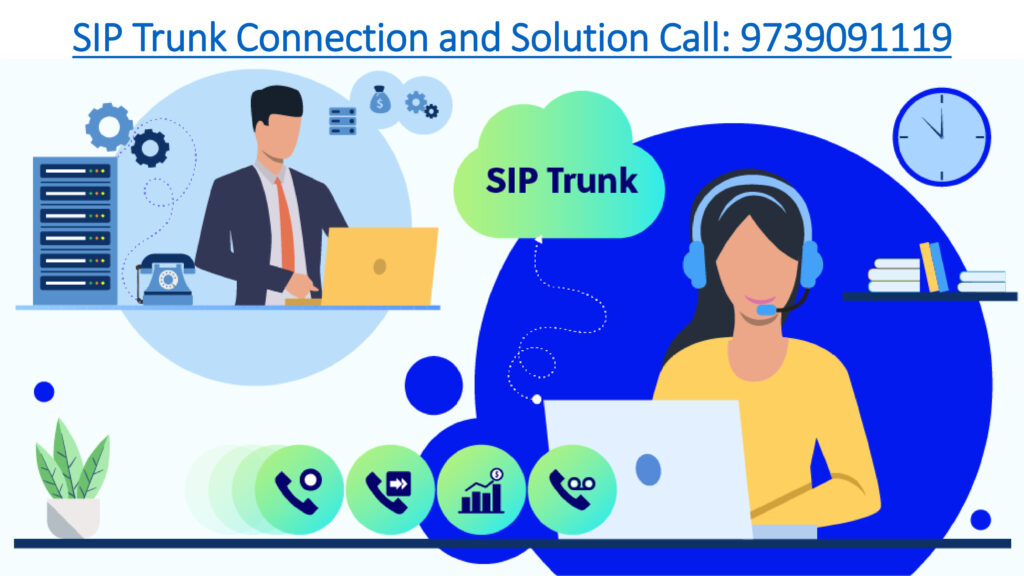Tata SIP (Session Initiation Protocol) Trunking solution, Service and Connection Provider in Bangalore and Chennai for Price/Cost Tariff Plans Call: 9739091119
Tata offers a robust SIP Trunking solution designed to modernize enterprise voice communications by replacing traditional ISDN lines with scalable, internet-based PSTN services.

SIP Trunk: Never Miss a Call Again
Harness the power of a flexible, scalable, and futuristic IP-based voice solution
A SIP (Session Initiation Protocol) Trunk is a modern telecommunication method that uses the internet to transmit voice, video, and other unified communications services. It replaces traditional physical phone lines like PRI (Primary Rate Interface) with a virtual, IP-based solution. SIP trunks are highly scalable, cost-effective, and well-suited for businesses of all sizes.
SIP Trunk vs. PRI:
| Feature | SIP Trunk | PRI Line |
|---|---|---|
| Technology | Internet-based (VoIP) | Physical line (ISDN) |
| Scalability | Highly scalable | Limited to fixed channels (23/30) |
| Cost | Lower operational costs | Higher costs |
| Call Quality | Depends on internet quality | Consistently reliable |
| Setup Flexibility | Easy to deploy and configure | Requires physical infrastructure |
When exploring Tata’s SIP trunk plans, it’s important to recognize that these are business-focused solutions designed to modernize and streamline voice communications. Here’s a breakdown of key aspects:
- Modern Voice Communication:
- SIP (Session Initiation Protocol) trunking allows businesses to make and receive phone calls over an IP (Internet Protocol) network.
- It replaces traditional phone lines like PRI (Primary Rate Interface) with a more flexible and scalable solution.
- Benefits:
- Cost-effectiveness: Often reduces communication costs compared to traditional phone systems.
- Scalability: Easily add or remove channels as needed.
- Flexibility: Enables features like direct inward dialing (DID) and integration with other IP-based communication tools.
Tata’s Two Core Offerings
1. Global SIP Trunk (via Tata Communications)
- International reach: supports local numbers, toll-free access, and international SIP trunks.
- High SLA reliability: carrier-grade uptime (~99.99%)
- API provisioning: automate number orders and trunk activation
- Enterprise telephony-ready: ideal for global operations needing consistent voice quality
2. Domestic SIP Trunk (via Tata Tele Business Services)
- India-focused service supports 20–1,500 concurrent channels per link
- Redundancy built-in: dual last-mile failover and automatic switchovers
- Channel-on-demand: scale up/down without hardware changes
- Voice quality monitoring: real-time dashboards, HD codec (G.711) support
Here’s a comprehensive comparison between Tata and JIO SIP Trunk solutions — both offer VoIP-based telephony for businesses, enabling scalable, cost-effective voice communication over IP networks.
Tata SIP Trunk Solution Tariff Plan, ideal for businesses that want to move from traditional PRI lines to IP-based voice services using their PBX system over a broadband or leased line connection.
🔗 What is Tata SIP Trunking?
SIP Trunking (Session Initiation Protocol) allows your IP-enabled PBX to make and receive voice calls over the internet (VoIP) instead of a physical PRI line. Tata’s SIP solution provides scalable, cost-effective, and high-quality voice communication.
💰 Tata SIP Trunk Tariff Plans (Indicative)
| Plan Type | No. of Channels | Approx. Monthly Rental | Free Call Value |
|---|---|---|---|
| Starter SIP Plan | 10 Channels | ₹3,500 – ₹5,000 | ₹1,000 – ₹2,000 worth of calls |
| Business SIP Plan | 30 Channels | ₹7,000 – ₹9,000 | ₹2,500 – ₹4,000 worth of calls |
| Enterprise Plan | 60+ Channels | ₹12,000 – ₹20,000+ | Custom / unlimited bundles |
| Pay-as-you-go | Flexible Channels | ₹200–₹300 per channel | Call usage billed separately |
📌 Per Channel = One Simultaneous Call
✅ Standard Features
| Feature | Description |
|---|---|
| 📞 HD Voice Quality | Runs over secure IP/MPLS network or ILL |
| 🔢 DID/DDI Support | Direct Inward Dialing number blocks |
| 🔐 Secure | TLS & SRTP encryption available |
| 🔄 Failover Routing | Automatic rerouting in case of link failure |
| 🧠 Scalable | Add/remove channels easily without new hardware |
| 💼 Compatible | Works with IP PBX like Avaya, Cisco, 3CX, NEC, etc. |
🧩 Key Features of Tata SIP Trunk
| Feature | Benefit |
|---|---|
| 99.5% SLA-backed uptime | Ensures reliable voice connectivity |
| Dual last-mile auto-failover | Seamless backup during outages |
| Real-time SIP monitoring | Full visibility into call traffic and performance |
| HD voice quality | Crystal-clear calls using G.711 codec |
| Flexible DID blocks | Start with 100 Direct Inward Dialing numbers and scale as needed |
| Channel-on-demand | Add/remove channels instantly |
| Seamless PBX integration | Works with existing infrastructure |
🧾 Add-ons & One-time Charges (Typical)
| Item | Charges |
|---|---|
| DID Number Block | ₹500 – ₹1,000 per block |
| Setup & Installation | ₹1,000 – ₹2,500 one-time |
| CLIP/CLIR Activation | ₹500 – ₹1,000 |
| SIP Gateway (if needed) | ₹5,000 – ₹20,000 |
📍 Who Should Use Tata SIP Trunks?
- 📈 Call centers, support centers, and enterprises using IP-PBX
- 🏢 multi-location businesses with central call routing
- 🔁 Companies replacing traditional PRI with flexible VoIP
- 💻 Cloud-based businesses integrating with CRMs or CPaaS
📞 How to Get Tata SIP Trunk Connection
☎️ Contact: 9739091119
Here are top providers of Tata SIP Trunk Solutions in Bangalore, offering scalable, IP-based voice connectivity for modern enterprises:
🏢 Tata Tele Business Services (TTBS) – SIP Trunk
- Service: IP-based voice solution replacing traditional PRI lines
- Key Features:
- Supports 20 to 1,500 simultaneous calls
- SLA-backed uptime (99.5%)
- Dual last-mile auto-failover
- Real-time SIP monitoring
- HD voice quality (G.711 codec)
- Flexible DID blocks starting from 100 numbers
Plans:
- SIP 250: ₹250/month, ₹250 free call value
- SIP 350: ₹350/month, ₹350 free call value
- SIP 500: ₹500/month, ₹500 free call value
📍 Tata SIP Trunk Provider
- Location: Bengaluru and Chennai
- Phone: 📞 9739091119
- Highlights:
- VoIP-based SIP trunking with unlimited channels
- Global reach and unified communication integration
- Automatic failover and redundancy
- Supports direct inward dialing (DID)
🔍 Why Choose Tata SIP Trunk?
| Feature | SIP Trunk | PRI Line |
|---|---|---|
| Technology | Internet-based (VoIP) | Physical line (ISDN) |
| Scalability | Highly scalable | Fixed channels (30) |
| Cost | Lower operational costs | Higher costs |
| Setup Flexibility | Easy to deploy and configure | Requires physical infrastructure |
| Call Quality | Depends on internet quality | Consistently reliable |
SIP Trunking is a modern, scalable voice solution that replaces traditional phone lines with internet-based calling, ideal for businesses seeking flexibility and cost savings.
Here’s a detailed Q&A to help you understand SIP Trunk services in India:
How SIP Trunk work?
- SIP trunks use VoIP (Voice over IP) to transmit calls.
- They connect via broadband or dedicated internet to your PBX system.
- Each trunk can support multiple simultaneous calls, depending on bandwidth and configuration
What are the key features in Tata SIP Trunk?
- Scalable Call Capacity: Supports from 20 to 1,500 concurrent calls
Dual Last-Mile Redundancy: Ensures business continuity with automatic failover
HD Voice Quality: Crystal-clear audio for professional communication
SLA-Backed Uptime: Guarantees high availability and reliability
Flexible Deployment: Works with on-premise or cloud-based PBX systems
What is the price of Tata SIP Trunking?
- Starting Price: Around ₹5,000–₹15,000/month for basic configurations
Enterprise Plans: Can scale up based on:
Number of concurrent calls (from 20 to 1,500)
SLA terms (uptime, MTTR)
Add-ons like CLI, DID, WhatsApp integration
Redundancy and failover options
For example, Tata’s SIP Trunk service supports 20 to 1,500 simultaneous calls, with dual last-mile redundancy, HD voice, and real-time monitoring
What’s included Tata SIP Trunk Solution?
- SLA-backed uptime
- High-definition voice quality
- Scalable call channels
- Failover routing and disaster recovery
- Nationwide coverage
Who should use Tata SIP Trunking?
- Call centers and customer support teams
- Enterprises with remote or hybrid workforces
- Businesses migrating from PRI to IP-based systems
- Companies needing CRM or WhatsApp voice integration
How to get a Tata SIP Trunk Connection quote?
You can Contact: 9739091119 for pricing in India - Bengaluru and Chennai
If I have a Tata PRI line now, can I convert it to the Tata SIP trunk easily?
Tata Tele says “No direct migration; a new SIP Trunk order is required.”
What happens if the internet/last-mile link fails?
Tata offers dual last‐mile auto‐failover and alternate links for business continuity. Example: case study mentioned calls being forwarded to mobile phones as fallback.
